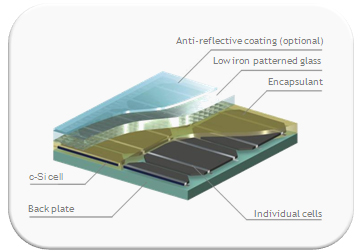Crystalline Silicon Photovoltaics
Characteristics of crystalline silicon photovoltaics
Crystalline silicon photovoltaics is the most widely used photovoltaic technology. Crystalline silicon photovoltaics are modules built using crystalline silicon solar cells (c-Si), developed from the microelectronics technology industry.
Crystalline silicon solar cells have high efficiency, making crystalline silicon photovoltaics an interesting technology where space is at a premium.

Crystalline silicon solar cells
There are two types of crystalline silicon solar cells used in crystalline silicon photovoltaics:
- Mono-crystalline silicon, produced by slicing wafers from a high-purity single crystal ingot
- Multi-crystalline silicon, made by sawing a cast block of silicon first into bars and then into wafers
Mono-crystalline silicon solar cells have higher efficiencies than multi-crystalline silicon solar cells.
In crystalline silicon photovoltaics, solar cells are generally connected together and then laminated under toughened, high transmittance glass to produce reliable, weather resistant photovoltaic modules. The glass type normally used for this technology is rolled low iron glass such as
Pilkington Sunplus™, often in toughened form, combined with an anti-reflective coating, to ensure that the maximum solar radiation reaches the crystalline silicon solar cells. It is also possible to use low iron float glass such as
Pilkington Optiwhite™.
For more information on our
solar glass product range, please read our
solar glass literature or stay up-to-date with our latest
solar glass news.